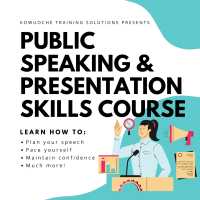Description
In this course, you will :
- Substantial increase your confidence and presence as a dynamic speaker..
- Develop delivery techniques for voice, movement, and gesture that engage audiences..
- Prepare effective speeches for various purposes (informative, persuasive, praise), occasions (workplace, special events, etc.), and audiences..
- Master speechwriting techniques for storytelling, argument, style, topic framing, and discussing evidence..
Good speaking is your most enduring job skill. This four-course specialization will provide you with the instruction, experience, and practice to develop and deliver compelling presentations. Drawing from the established knowledge in communication, rhetoric, linguistics, and argumentation, each course balances proven ideas with lots of speech practice. The courses in this specializations should help speakers at all levels. If you are nervous about public speaking, this is for you! I have spent an entire career helping nervous novice speakers grow into confident communicators. We slowly work up specific skills that you can practice multiple times before putting together a longer speech. This course gives you a reliable model for preparing and delivering effective presentations. In business, in school, and in public life, we are often called upon to “make a few comments.” Often, people tasked with such speeches become flummoxed. They might not know what to talk about, or ramble without making a point, or simply be confusing to listen to. This course is designed to help you shine where others falter. We’ll learn how organize talks clearly, write them memorably, and deliver them confidently. By the end of the course, you should be able to significantly reduce your fear of public speaking, use rehearsal techniques to develop a strong, vibrant speaking voice, and perform speeches with dynamic movement and gestures. The speech model that we’ll practice is useful for briefings, elevator talks, interviews, and even as a structure for hour-long presentations. If you’re a beginner, this course will help you quickly master the fundamentals of speaking. If you’re a seasoned speaker, this course will help you better understand public speaking and push you to the next level. In the professional realm, most speeches and presentations we give are informative in scope. A scientist needs to explain her recent research findings. A financial officer needs to report on quarterly earnings to his company’s board. A technology professional needs to educate a consumer about a new product. Any time you need to convey ideas or demonstrate a process, you’re dealing with informative speaking. Informative speaking is a fun puzzle. You need to think from the perspective of your audience to identify what they need to hear in order to understand the key ideas. How much does the audience already know? What are the most important elements to convey? How should one convey these ideas with appropriate breadth and depth given the time constraints of the speech? This demands a strategic approach to speech design that we’ll undertake in this class. By the end of the course, you should be able to explain complex ideas vividly and accessibly, design clear and compelling presentation slides, convey your passion for a topic while maintaining your professional credibility, and speak dynamically from notes and/or a manuscript. Learners will record speeches, providing and receiving peer feedback. In the professional realm, we need to be able to argue without being argumentative. Whether you are fundraising for a nonprofit, pitching a business proposal, or suggesting a change to company policy, you are making arguments. In making the case for your topic, you often want to raise awareness, identify a pressing problem, discuss appropriate solutions, and outline specific steps for the audience. To be persuasive, you must be clear (the audience may have little to no existing knowledge), you must be convincing (you are trying to sway the audience that your argument is valid), and you must be compelling (you are trying to motivate the audience enough so that they want to take specific actions). Persuasive speaking thus requires clarity, strategy, topic mastery, plus a sense of style and presence. By the end of this course, you should be able to design persuasive speeches that address problems and solutions and that motivate audience members. You should be able to use rhetorical style strategically and deliver passionate and compelling speeches. Learners will record speeches, providing and receiving peer feedback. The most memorable speeches inspire, entertain, and praise. By blending stories and eloquence, great speeches highlight the core values motivating an audience. You might need to do this in a keynote address, a eulogy, or simply a business meeting. Inspiring audiences is a common, but difficult writing challenge. You want a speech that elevates the topic and the audience. This course gives you a method for preparing and delivering speeches that inspire and entertain. By the end of this course, you should be able to compose and deliver moving speeches that praise core audience values through evidence, storytelling, and humor. You should be able to write eloquent passages in tones appropriate to the audience and occasion and speak fluidly from either a well-prepared manuscript or from memory. Learners will record speeches, providing and receiving peer feedback.
This course gives you a reliable model for preparing and delivering effective presentations. In business, in school, and in public life, we are often called upon to “make a few comments.” Often, people tasked with such speeches become flummoxed. They might not know what to talk about, or ramble without making a point, or simply be confusing to listen to. This course is designed to help you shine where others falter. We’ll learn how organize talks clearly, write them memorably, and deliver them confidently. By the end of the course, you should be able to significantly reduce your fear of public speaking, use rehearsal techniques to develop a strong, vibrant speaking voice, and perform speeches with dynamic movement and gestures. The speech model that we’ll practice is useful for briefings, elevator talks, interviews, and even as a structure for hour-long presentations. If you’re a beginner, this course will help you quickly master the fundamentals of speaking. If you’re a seasoned speaker, this course will help you better understand public speaking and push you to the next level.
In the professional realm, most speeches and presentations we give are informative in scope. A scientist needs to explain her recent research findings. A financial officer needs to report on quarterly earnings to his company’s board. A technology professional needs to educate a consumer about a new product. Any time you need to convey ideas or demonstrate a process, you’re dealing with informative speaking. Informative speaking is a fun puzzle. You need to think from the perspective of your audience to identify what they need to hear in order to understand the key ideas. How much does the audience already know? What are the most important elements to convey? How should one convey these ideas with appropriate breadth and depth given the time constraints of the speech? This demands a strategic approach to speech design that we’ll undertake in this class. By the end of the course, you should be able to explain complex ideas vividly and accessibly, design clear and compelling presentation slides, convey your passion for a topic while maintaining your professional credibility, and speak dynamically from notes and/or a manuscript. Learners will record speeches, providing and receiving peer feedback.
In the professional realm, we need to be able to argue without being argumentative. Whether you are fundraising for a nonprofit, pitching a business proposal, or suggesting a change to company policy, you are making arguments. In making the case for your topic, you often want to raise awareness, identify a pressing problem, discuss appropriate solutions, and outline specific steps for the audience. To be persuasive, you must be clear (the audience may have little to no existing knowledge), you must be convincing (you are trying to sway the audience that your argument is valid), and you must be compelling (you are trying to motivate the audience enough so that they want to take specific actions). Persuasive speaking thus requires clarity, strategy, topic mastery, plus a sense of style and presence. By the end of this course, you should be able to design persuasive speeches that address problems and solutions and that motivate audience members. You should be able to use rhetorical style strategically and deliver passionate and compelling speeches. Learners will record speeches, providing and receiving peer feedback.
The most memorable speeches inspire, entertain, and praise. By blending stories and eloquence, great speeches highlight the core values motivating an audience. You might need to do this in a keynote address, a eulogy, or simply a business meeting. Inspiring audiences is a common, but difficult writing challenge. You want a speech that elevates the topic and the audience. This course gives you a method for preparing and delivering speeches that inspire and entertain. By the end of this course, you should be able to compose and deliver moving speeches that praise core audience values through evidence, storytelling, and humor. You should be able to write eloquent passages in tones appropriate to the audience and occasion and speak fluidly from either a well-prepared manuscript or from memory. Learners will record speeches, providing and receiving peer feedback.









